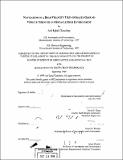| dc.contributor.advisor | James K. Kuchar. | en_US |
| dc.contributor.author | Chaudhry, Atif Iqbal, 1973- | en_US |
| dc.contributor.other | Massachusetts Institute of Technology. Dept. of Aeronautics and Astronautics. | en_US |
| dc.date.accessioned | 2010-01-07T20:51:49Z | |
| dc.date.available | 2010-01-07T20:51:49Z | |
| dc.date.copyright | 1999 | en_US |
| dc.date.issued | 1999 | en_US |
| dc.identifier.uri | http://hdl.handle.net/1721.1/50549 | |
| dc.description | Thesis (S.M.)--Massachusetts Institute of Technology, Dept. of Aeronautics and Astronautics, 1999. | en_US |
| dc.description | Includes bibliographical references (leaf 41). | en_US |
| dc.description.abstract | An experiment was designed and conducted to investigate the use of a priori overhead images in navigating an unmanned tele-operated ground vehicle through an obstacle rich environment. The obstacle courses contained many of the same types of elements that would exist in an urban setting. The corresponding a priori images depicted these obstacle courses but included some drawbacks that could be expected in an overhead image of an urban environment. For instance there were objects on the course that were not depicted on the overhead image and vice versa. The overhead images were prepared in low, medium, and high resolutions. These resolutions, one meter, half meter, and centimeter scale, were selected to be representative of what might be available in real situations. Subjects controlled the vehicle using a joystick, with reference to the a priori image and a real-time video image from the vehicle. The subjects' times to navigate the courses and their paths were recorded during the experiment. From this information, post analysis showed what types of decision errors they made on each course. Statistical analysis showed that there was no significant performance difference between the three different obstacle courses. Subjects took the longest time to navigate the courses using the low resolution overhead images, and took the shortest time with the high resolution images. There was a statistically significant difference between the average course completion time with the medium resolution map and the high resolution map. Medium and high resolution lead subjects to rely less on the video image from the vehicle. This caused them to occasionally make incorrect navigation choices. With low resolution subjects tended to use clearly discernible paths and avoid shortcuts which could have saved time. This nuance in the behavior with different resolutions underscores the importance of experimentation and suggests that further study is necessary. | en_US |
| dc.description.statementofresponsibility | by Atif Iqbal Chaudhry. | en_US |
| dc.format.extent | 45 leaves | en_US |
| dc.language.iso | eng | en_US |
| dc.publisher | Massachusetts Institute of Technology | en_US |
| dc.rights | M.I.T. theses are protected by
copyright. They may be viewed from this source for any purpose, but
reproduction or distribution in any format is prohibited without written
permission. See provided URL for inquiries about permission. | en_US |
| dc.rights.uri | http://dspace.mit.edu/handle/1721.1/7582 | en_US |
| dc.subject | Aeronautics and Astronautics. | en_US |
| dc.title | Navigation of a high velocity tele-operated ground vehicle through an obstacle rich environment | en_US |
| dc.type | Thesis | en_US |
| dc.description.degree | S.M. | en_US |
| dc.contributor.department | Massachusetts Institute of Technology. Department of Aeronautics and Astronautics | |
| dc.identifier.oclc | 44606588 | en_US |
